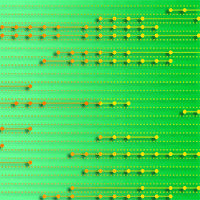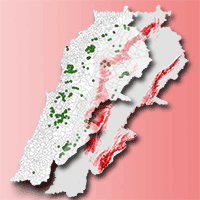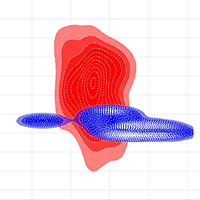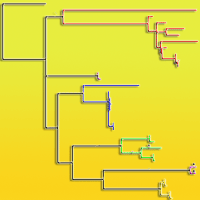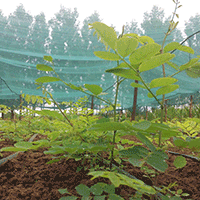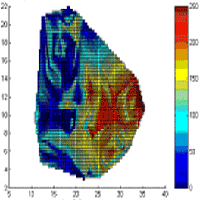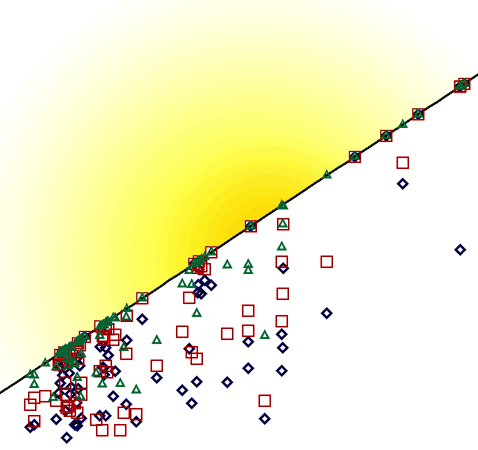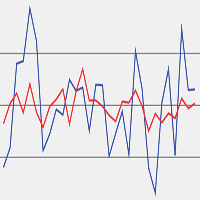The cultivation of hybrid poplar clones is increasing worldwide. Hundreds of hectares of plantations now occur across Europe and other continents such as North America, using tested clones and novel genotypes. Research effort aims are to develop fast growing disease- and pest-resistant clones to improve production quality and quantity. In this study the phenotypic plasticity of poplar clones was tested across environmental and temporal gradients. The growth performance of 49 hybrid poplar clones recorded between 1980 and 2021 was analysed using a mixed-effects model with climatic data as a predictor variable. Clones were aggregated into two groups according to their breeding protocol (i.e., standard clone, and improved material) and their growth modelled for future climate scenarios of RCPs 2.6 and 8.5 using a downscaled version of the variants 01 and 21 of UKCP18 climate projections dataset for three 30-year normal period time-slices: 2030s, 2040s, 2050s. The fitted growth models showed highly significant results, explaining more than 85% of the variance, with a mean relative absolute error of approximately 2%. Improved material showed more resistance to warmer and drier climates and less sensitivity to the changing climate. While no unique pattern was found when comparing growth performances, new improved clones were more productive than older clones (e.g., “I-214”) with an additional benefit of resistance to rust and pests. Spatial predictions confirmed the Po valley as the most important geographic area for poplar cultivation in Italy, but zones in Central and Southern Italy show potential. However, the Po Valley is also where poplars are predicted to be suitable in the next decades with large uncertainties. The analysis identified the need for more research on the topic of poplar breeding. For example, models using the most extreme (warm and dry) climate projection, variant 01 of RCP8.5 of the UKCP18, exceeded the historic climate threshold, and predictions used model extrapolation, with associated statistical uncertainty. Therefore, predictions should be considered with care and more research effort is required to test clones over wider environmental conditions.
Keywords
, , ,
Citation
Marchi M, Bergante S, Ray D, Barbetti R, Facciotto G, Chiarabaglio PM, Hynynen J, Nervo G (2022). Universal reaction norms for the sustainable cultivation of hybrid poplar clones under climate change in Italy. iForest 15: 47-55. - doi: 10.3832/ifor3989-015
Academic Editor
Gianfranco Minotta
Paper history
Received: Oct 04, 2021
Accepted: Jan 12, 2022
First online: Feb 08, 2022
Publication Date: Feb 28, 2022
Publication Time: 0.90 months
© SISEF - The Italian Society of Silviculture and Forest Ecology 2022
Open Access
This article is distributed under the terms of the Creative Commons Attribution-Non Commercial 4.0 International (https://creativecommons.org/licenses/by-nc/4.0/), which permits unrestricted use, distribution, and reproduction in any medium, provided you give appropriate credit to the original author(s) and the source, provide a link to the Creative Commons license, and indicate if changes were made.

Breakdown by View Type
(Waiting for server response...)
Article Usage
Total Article Views: 31561
(from publication date up to now)
Breakdown by View Type
HTML Page Views: 26685
Abstract Page Views: 2623
PDF Downloads: 1757
Citation/Reference Downloads: 5
XML Downloads: 491
Web Metrics
Days since publication: 1409
Overall contacts: 31561
Avg. contacts per week: 156.80
Article Citations
Article citations are based on data periodically collected from the Clarivate Web of Science web site
(last update: Mar 2025)
Total number of cites (since 2022): 17
Average cites per year: 4.25
Publication Metrics
by Dimensions ©
Articles citing this article
List of the papers citing this article based on CrossRef Cited-by.
(1)
Bates D, Mächler M, Bolker BM, Walker SC (2015)Fitting linear mixed-effects models using lme4. Journal of Statistical Software 67: 1-48.
CrossRef |
Gscholar
(2)
Benito Garzón M, Robson TM, Hampe A (2019)ΔTraitSDM: species distribution models that account for local adaptation and phenotypic plasticity. New Phytologist 222: 1757-1765.
CrossRef |
Gscholar
(3)
Bergante S, Facciotto G, Marchi M (2020)Growth dynamics of “Imola” poplar clone (
Populus × canadensis Mönch) under different cultivation inputs. Annals of Silvicultural Research 44: 71-79.
CrossRef |
Gscholar
(4)
Berlin M, Persson T, Jansson G, Haapanen M, Ruotsalainen S, Bärring L, Gull BA (2016)Scots pine transfer effect models for growth and survival in Sweden and Finland. Silva Fennica 50: 1-21.
CrossRef |
Gscholar
(5)
Boiffin J, Badeau V, Bréda N (2017)Species distribution models may misdirect assisted migration: insights from the introduction of Douglas-fir to Europe. Ecological Applications 27: 446-457.
CrossRef |
Gscholar
(6)
Booth TH (2018)Species distribution modelling tools and databases to assist managing forests under climate change. Forest Ecology and Management 430: 196-203.
CrossRef |
Gscholar
(7)
Chakraborty D, Wang T, Andre K, Konnert M, Lexer MJ, Matulla C, Schueler S (2015)Selecting populations for non-analogous climate conditions using universal response functions: the case of douglas-fir in central Europe. PLoS One 10: 1-21.
CrossRef |
Gscholar
(8)
Chakraborty D, Wang T, Andre K, Konnert M, Lexer MJ, Matulla C, Weienbacher L, Schueler S (2016)Adapting Douglas-fir forestry in Central Europe: evaluation, application, and uncertainty analysis of a genetically based model. European Journal of Forest Research 135: 919-936.
CrossRef |
Gscholar
(9)
Chiarabaglio PM, Allegro G, Rossi A, Savi L (2014)Studi sulla sostenibilità della pioppicoltura in Lombardia [Studies on sustainability of poplar cultivation in Lombardy]. Sherwood 206: 5-8. [in Italian]
Gscholar
(10)
Cook BI, Mankin JS, Marvel K, Williams AP, Smerdon JE, Anchukaitis KJ (2020)Twenty-first century drought projections in the CMIP6 forcing scenarios. Earth’s Future 8: 1-20.
CrossRef |
Gscholar
(11)
Corona P, Chianucci F, Marcelli A, Gianelle D, Fattorini L, Grotti M, Puletti N, Mattioli W (2020)Probabilistic sampling and estimation for large-scale assessment of poplar plantations in Northern Italy. European Journal of Forest Research 139: 981-988.
CrossRef |
Gscholar
(12)
Daly C, Halbleib M, Smith JI, Gibson WP, Doggett MK, Taylor GH, Curtis J, Pasteris PP (2008)Physiographically sensitive mapping of climatological temperature and precipitation across the conterminous United States. International Journal of Climatology 28: 2031-2064.
CrossRef |
Gscholar
(13)
Dimitriou I, Aronsson P (2011)Wastewater and sewage sludge application to willows and poplars grown in lysimeters - Plant response and treatment efficiency. Biomass and Bioenergy 35: 161-170.
CrossRef |
Gscholar
(14)
Elith J, Graham CH, Anderson RP, Dudík M, Ferrier S, Guisan A, Hijmans RJ, Huettmann F, Leathwick JR, Lehmann A, Li J, Lohmann LG, Loiselle BA, Manion G, Moritz C, Nakamura M, Nakazawa Y, Overton JMC, Peterson AT, Phillips SJ, Richardson K, Scachetti-Pereira R, Schapire RE, Soberón J, Williams S, Wisz MS, Zimmermann NE (2006)Novel methods improve prediction of species’ distributions from occurrence data. Ecography 29 (2): 129-151.
CrossRef |
Gscholar
(15)
Fréjaville T, Fady B, Kremer A, Ducousso A, Benito Garzón M (2019)Inferring phenotypic plasticity and local adaptation to climate across tree species ranges using forest inventory data. Global Ecology and Biogeography 28 (9): 1-34.
CrossRef |
Gscholar
(16)
Galván L, Olías M, Izquierdo T, Cerón JC, Fernández De Villarán R (2014)Rainfall estimation in SWAT: an alternative method to simulate orographic precipitation. Journal of Hydrology 509: 257-265.
CrossRef |
Gscholar
(17)
Gidden MJ, Riahi K, Smith SJ, Fujimori S, Luderer G, Kriegler E, Van Vuuren DP, Van Den Berg M, Feng L, Klein D, Calvin K, Doelman JC, Frank S, Fricko O, Harmsen M, Hasegawa T, Havlik P, Hilaire J, Hoesly R, Horing J, Popp A, Stehfest E, Takahashi K (2019)Global emissions pathways under different socioeconomic scenarios for use in CMIP6: a dataset of harmonized emissions trajectories through the end of the century. Geoscientific Model Development 12: 1443-1475.
CrossRef |
Gscholar
(18)
Gielen B, Calfapietra C, Lukac M, Wittig VE, De Angelis P, Janssens IA, Moscatelli MC, Grego S, Cotrufo MF, Godbold DL, Hoosbeek MR, Long SP, Miglietta F, Polle A, Bernacchi CJ, Davey PA, Ceulemans R, Scarascia-Mugnozza GE (2005)Net carbon storage in a poplar plantation (POPFACE) after three years of free-air CO
2 enrichment. Tree Physiology 25: 1399-1408.
CrossRef |
Gscholar
(19)
Hallingbäck HR, Burton V, Vizcaíno-Palomar N, Trotter F, Liziniewicz M, Marchi M, Berlin M, Ray D, Benito-Garzón M (2021)Managing uncertainty in Scots pine range-wide adaptation under climate change. Frontiers in Ecology and Evolution 9 (724051): 1-18.
CrossRef |
Gscholar
(20)
Harris I, Osborn TJ, Jones P, Lister D (2020)Version 4 of the CRU TS monthly high-resolution gridded multivariate climate dataset. Scientific Data 7: 109.
CrossRef |
Gscholar
(21)
Hemery GE, Savill PS, Thakur A (2005)Height growth and flushing in common walnut (
Juglans regia L.): 5-year results from provenance trials in Great Britain. Forestry 78: 121-133.
CrossRef |
Gscholar
(22)
Hijmans RJ, Cameron SE, Parra JL, Jones G, Jarvis A (2005)Very high resolution interpolated climate surfaces for global land areas. International Journal of Climatology 25: 1965-1978.
CrossRef |
Gscholar
(23)
Hjelm K, Rytter L (2016)The influence of soil conditions, with focus on soil acidity, on the establishment of poplar (
Populus spp.). New Forests 47: 731-750.
CrossRef |
Gscholar
(24)
Isaac-Renton MG, Roberts DR, Hamann A, Spiecker H (2014)Douglas-fir plantations in Europe: a retrospective test of assisted migration to address climate change. Global Change Biology 20: 2607-2617.
CrossRef |
Gscholar
(25)
Lefèvre F, Barsoum N, Heinze B, Kajba D, Rotach P, Vries De SMG (2001)In situ conservation of
Populus nigra. International Plant Genetic Resources - IPGRI/EUFORGEN, Rome, Italy, pp. 58.
Online |
Gscholar
(26)
Lowe JA, Bernie D, Bett P, Bricheno L, Brown S, Calvert D, Clark R, Eagle K, Edwards T, Fosser G, Fung F, Gohar L, Good P, Gregory J, Harris G, Howard T, Kaye N, Kendon E, Krijnen J, Maisey P, McDonald R, McInnes R, McSweeney C, Mitchell JF, Murphy J, Palmer M, Roberts C, Rostron J, Sexton D, Thornton H, Tinker J, Tucker S, Yamazaki K, Belcher S (2019)UKCP18 science overview report version 2.0. Met Office, London, UK, pp. 79.
Gscholar
(27)
Marchi M (2019)Nonlinear
versus linearised model on stand density model fitting and stand density index calculation: analysis of coefficients estimation
via simulation. Journal of Forestry Research 30: 1595-1602.
CrossRef |
Gscholar
(28)
Marchi M, Castellanos-Acuña D, Hamann A, Wang T, Ray D, Menzel A (2020)ClimateEU, scale-free climate normals, historical time series, and future projections for Europe. Scientific Data 7: 428.
CrossRef |
Gscholar
(29)
Marchi M, Cocozza C (2021)Probabilistic provenance detection and management pathways for
Pseudotsuga menziesii (Mirb.) Franco in Italy using climatic analogues. Plants 10 (2): 215.
CrossRef |
Gscholar
(30)
Matyas C (1994)Modeling climate change effects with provenance test data. Tree Physiology 14: 797-804.
CrossRef |
Gscholar
(31)
Müller M, Kempen T, Finkeldey R, Gailing O (2020)Low population differentiation but high phenotypic plasticity of European beech in Germany. Forests 11: 1-14.
CrossRef |
Gscholar
(32)
O’Neill GA, Hamann A, Wang TL (2008)Accounting for population variation improves estimates of the impact of climate change on species’ growth and distribution. Journal of Applied Ecology 45: 1040-1049.
CrossRef |
Gscholar
(33)
Pecchi M, Marchi M, Burton V, Giannetti F, Moriondo M, Bernetti I, Bindi M, Chirici G (2019)Species distribution modelling to support forest management. A literature review. Ecological Modelling 411: 108817.
CrossRef |
Gscholar
(34)
Polle A, Janz D, Teichmann T, Lipka V (2013)Poplar genetic engineering: promoting desirable wood characteristics and pest resistance. Applied Microbiology and Biotechnology 97 (13): 5669-5679.
CrossRef |
Gscholar
(35)
Pretzsch H (2009)Forest dynamics, growth and yield - From measurement to model. Springer-Verlag, Berlin, Heidelberg, Germany, pp. 423-491.
CrossRef |
Gscholar
(36)
Pretzsch H, Biber P, Schütze G, Uhl E, Rötzer T (2014)Forest stand growth dynamics in Central Europe have accelerated since 1870. Nature Communications 5 (1): 1065.
CrossRef |
Gscholar
(37)
Pukkala T (2017)Transfer and response functions as a means to predict the effect of climate change on timber supply. Forestry 90: 573-580.
CrossRef |
Gscholar
(38)
R Development Core Team (2020)R: a language and environment for statistical computing. R Foundation for Statistical Computing, Vienna, Austria.
Online |
Gscholar
(39)
Ray D, Xenakis G, Tene A, Black K (2009)Developing a site classification system to assess the impact of climate change on species selection in Ireland. Irish Forestry 66: 101-122.
Online |
Gscholar
(40)
Rennenberg H, Wildhagen H, Ehlting B (2010)Nitrogen nutrition of poplar trees. Plant Biology 12: 275-291.
CrossRef |
Gscholar
(41)
Schreiber SG, Hamann A, Hacke UG, Thomas BR (2013)Sixteen years of winter stress: an assessment of cold hardiness, growth performance and survival of hybrid poplar clones at a boreal planting site. Plant, Cell and Environment 36: 419-428.
CrossRef |
Gscholar
(42)
Schueler S, Falk W, Koskela J, Lefèvre F, Bozzano M, Hubert J, Kraigher H, Longauer R, Olrik DC (2014)Vulnerability of dynamic genetic conservation units of forest trees in Europe to climate change. Global Change Biology 20: 1498-1511.
CrossRef |
Gscholar
(43)
Tang Y, Winkler JA, Viña A, Wang F, Zhang J, Zhao Z, Connor T, Yang H, Zhang Y, Zhang X, Li X, Liu J (2020)Expanding ensembles of species present-day and future climatic suitability to consider the limitations of species occurrence data. Ecological Indicators 110: 105891.
CrossRef |
Gscholar
(44)
Vizcaíno-Palomar N, Fady B, Alía R, Raffin A, Mutke S, Benito-Garzón M (2020)The legacy of climate variability over the last century on populations’ phenotypic variation in tree height. Science of the Total Environment 749: 141454.
CrossRef |
Gscholar
(45)
Wang T, Hamann A, Spittlehouse D, Carroll C (2016)Locally downscaled and spatially customizable climate data for historical and future periods for North America. PLoS One 11 (6): e0156720.
CrossRef |
Gscholar
(46)
Wang T, O’Neill GA, Aitken SN (2010)Integrating environmental and genetic effects to predict responses of tree populations to climate 20: 153-163.
Gscholar
(47)
Winans KS, Tardif AS, Lteif AE, Whalen JK (2015)Carbon sequestration potential and cost-benefit analysis of hybrid poplar, grain corn and hay cultivation in southern Quebec, Canada. Agroforestry Systems 89 (3): 421-433.
CrossRef |
Gscholar
(48)
Zhang Y, Tian Y, Ding S, Lv Y, Samjhana W, Fang S (2020)Growth, carbon storage, and optimal rotation in poplar plantations: a case study on clone and planting spacing effects. Forests 11: 1-15.
CrossRef |
Gscholar
